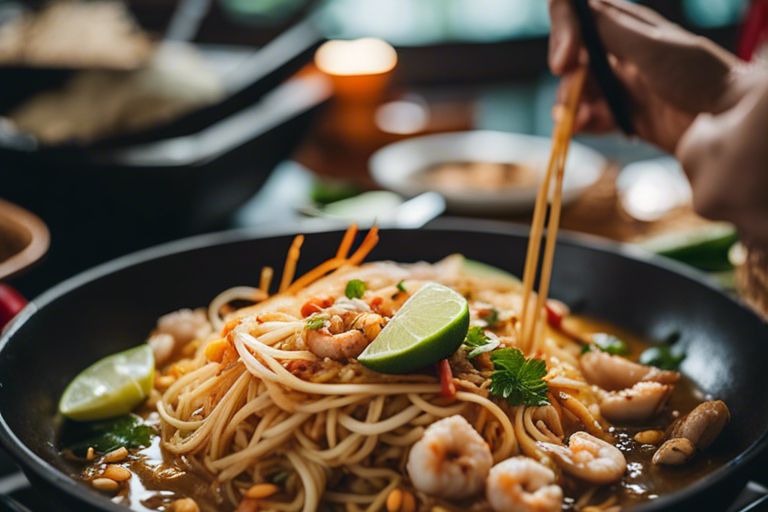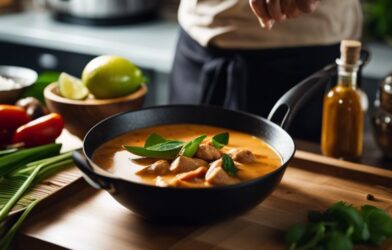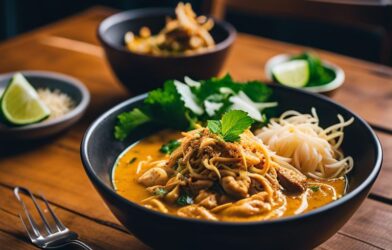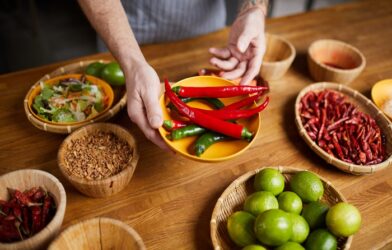Embark on a culinary journey through Thailand by learning how to create the beloved dish of Pad Thai in your own kitchen. This step-by-step guide will teach you the traditional techniques and vital ingredients needed to achieve the authentic flavors of this iconic Thai street food. From preparing the perfect noodle texture to mastering the balance of sweet, sour, salty, and spicy flavors, you will soon be able to enjoy a taste of Thailand right at home. Impress your friends and family with your newfound cooking skills and treat them to a delicious and genuine Pad Thai experience.
Ingredients and Substitutions
Essential Ingredients for Authentic Pad Thai
Some of the vital ingredients for authentic Pad Thai include rice noodles, tamarind paste, fish sauce, dried shrimp, tofu or shrimp, bean sprouts, eggs, garlic, shallots, and peanuts. These ingredients come together to create the signature sweet, sour, and savory flavors that characterize this classic Thai dish.
Suitable Substitutions for Dietary Restrictions
An important aspect of cooking Pad Thai is making suitable substitutions for dietary restrictions. While traditional Pad Thai contains fish sauce and dried shrimp, vegetarians can substitute with soy sauce and omit the shrimp. Those with gluten sensitivities can use gluten-free tamari instead of traditional soy sauce. Additionally, tofu or extra vegetables can be used as a replacement for shrimp or other proteins.
While it’s vital to stay true to the flavors of authentic Pad Thai, it’s also important to cater to individual dietary needs. By making these substitutions, individuals with dietary restrictions can still enjoy a delicious and satisfying plate of Pad Thai without compromising on taste.
Preparing Your Workspace
Necessary Cooking Equipment
If you want to make authentic Pad Thai, it’s necessary to have the right tools at your disposal. A wok or a large skillet is crucial for achieving that perfect stir-fry texture. Additionally, having a sharp chef’s knife, cutting board, and a spatula will make the cooking process much smoother. Invest in a good quality wok and utensils to ensure your Pad Thai turns out just like it would in Thailand.
Organizing Ingredients for Efficiency
On top of having the right cooking equipment, organizing your ingredients before you start cooking is key to efficiency in the kitchen. Make sure to have all your components measured, chopped, and ready to go before you turn on the heat. This preparation will help you stay focused and avoid any last-minute scrambles for missing ingredients.
Plus, separating your ingredients into different bowls according to the recipe instructions will make the cooking process seamless. This way, you can add each component at the right moment without overcooking or undercooking any part of your Pad Thai.
Cooking Process
Step 1: Preparing the Pad Thai Sauce
For an authentic Pad Thai flavor, it’s necessary to prepare the sauce correctly. Use a combination of tamarind paste, fish sauce, sugar, and chili paste to create a perfect balance of sour, salty, sweet, and spicy flavors.
Step 2: Soaking the Rice Noodles
Any good Pad Thai starts with properly soaked rice noodles. These noodles should be soft yet slightly firm to the bite. Soak the noodles in room temperature water for about 30-60 minutes until they are pliable but not mushy.
Step 3: Cooking the Protein
Some popular protein choices for Pad Thai include shrimp, chicken, tofu, or a combination of these. Cook the protein of your choice in a hot wok or skillet until it’s fully cooked before setting it aside for later use in the dish.
Step 4: Stir-Frying Vegetables and Noodles
Clearly, the key to perfect Pad Thai lies in the stir-frying technique. Heat oil in a wok, add vegetables like bean sprouts, green onions, and garlic, followed by the soaked and drained noodles. Stir-fry quickly to prevent sticking and ensure even cooking.
Step 5: Combining Ingredients and Final Touches
Little by little, add the prepared Pad Thai sauce to the stir-fried noodles and vegetables, tossing everything together until well-coated. The final touches might include a sprinkle of crushed peanuts, a squeeze of lime juice, and a garnish of fresh herbs like cilantro for a burst of freshness and flavor.
Serving and Presentation
Plating Authentic Pad Thai
Many consider the presentation of Pad Thai to be just as important as its taste. When serving this iconic dish, ensure that it is plated elegantly and attractively. Start by arranging the noodle mixture neatly on a plate and sprinkle with crushed peanuts and a few fresh cilantro leaves for a pop of color. A wedge of lime on the side not only adds to the visual appeal but also enhances the flavor.
Garnishes and Accompaniments
Little details can make a big difference when it comes to garnishing Pad Thai. Traditional garnishes for this dish include bean sprouts, chopped peanuts, fresh cilantro, and a lime wedge. These elements not only add texture and flavor but also lend authenticity to the dish. Serve Pad Thai with a side of sliced cucumber and a few wedges of cabbage for a refreshing contrast to the savory noodles.
To elevate the experience further, you can also offer additional garnishes and accompaniments such as crushed red pepper flakes, sliced green onions, and a small bowl of fish sauce on the side. These extras allow diners to customize their Pad Thai according to their preferences, adding a personalized touch to the meal.
Another tip for garnishing Pad Thai is to add a sprinkle of thinly sliced red chili peppers for a fiery kick. This not only adds heat but also enhances the overall presentation of the dish. Be mindful of, a balance of flavors, textures, and colors is key to creating an authentic and visually appealing Pad Thai.
Tips and Tricks for the Perfect Dish
Once again, creating an authentic Pad Thai requires attention to detail and some tried-and-true methods. To ensure you get it just right, follow these tips and tricks:
- Use tamarind paste for that necessary tangy flavor.
- Soak the rice noodles in warm water until flexible but still firm to the bite.
- Do not skimp on the peanuts and bean sprouts for added texture and crunch.
- Adjust the level of spiciness to suit your taste buds by adding more or less chili flakes.
- Garnish with fresh cilantro and lime wedges for an authentic touch.
Assume that attention to these details will result in a truly delicious Pad Thai every time.
Expert Advice for First-Timers
Clearly, mastering the art of making authentic Pad Thai takes practice and patience. If you’re new to cooking Thai cuisine, don’t be discouraged by any initial setbacks. Start with small batches and gradually refine your technique. Keep in mind, practice makes perfect!
Common Mistakes to Avoid
Now, one common mistake to avoid is using ketchup as a substitute for tamarind paste. While they may look similar, the flavor profile of ketchup is vastly different and will not give you the authentic taste you’re looking for. Additionally, overcooking the noodles can result in a mushy texture, so be sure to cook them until just al dente.
The key to a successful Pad Thai lies in balancing the sweet, sour, salty, and spicy flavors. Adding too much of one ingredient can throw off the entire dish. It’s crucial to taste and adjust as you go along to achieve the perfect harmony of flavors.
Conclusion
Now that you have learned the key ingredients and techniques to make authentic Pad Thai, you can enjoy the traditional taste of Thailand in the comfort of your own kitchen. By following these steps carefully and using fresh, quality ingredients, you can recreate this popular dish with ease. Experiment with different protein options, and don’t forget to garnish with lime, bean sprouts, and crushed peanuts for an extra burst of flavor. So why wait? Get your wok ready and start cooking your way to a delicious Pad Thai dish that will surely impress your friends and family.










Comments are closed